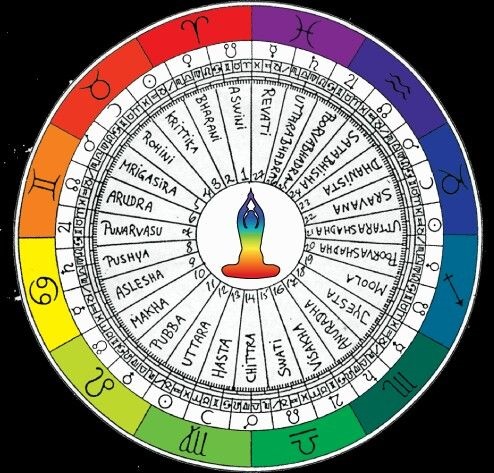In Vedic astrology, the moon holds a particularly significant role, and its position in the sky has been studied for centuries to gain insight into human nature, destiny, and cosmic events. One of the most profound systems used in Vedic astrology is the division of the sky into 27 lunar mansions or Nakshatras. These Nakshatras, also known as lunar constellations, are believed to influence the subtle energies at play during a person’s birth and throughout their life.
The concept of Nakshatras originates from ancient Indian astronomy and is deeply intertwined with astrology, where each Nakshatra has its own unique qualities, deity, and symbolic representation. Understanding these lunar mansions can offer deeper insights into an individual’s personality, relationships, and life path, providing a nuanced layer beyond the typical astrological signs.
What are Nakshatras?
Nakshatras are 27 divisions of the ecliptic, each spanning approximately 13 degrees and 20 minutes of the zodiac. They are based on the moon’s apparent movement across the sky, with the moon transiting through one Nakshatra every day. This system is unique to Vedic astrology and differs from Western astrology, where the zodiac signs (Aries, Taurus, etc.) play a dominant role.
Each Nakshatra is ruled by a specific planetary body and is associated with a particular deity, symbol, and set of qualities. These lunar mansions are considered more personal than the sun signs, as the moon moves more quickly and its influence shifts daily, providing a more intimate reflection of an individual’s mind, emotions, and intuition.
The 27 Nakshatras and Their Meanings
While each Nakshatra has a rich and complex mythology, here’s a brief overview of a few significant ones to illustrate their influence:
- Ashwini (0°00′ – 13°20′ Aries)
Symbol: Horse’s head
Ruling Planet: Ketu
Deity: Ashwini Kumaras, the twin horsemen
Qualities: Ashwini is known for its association with new beginnings, speed, and healing. Those born under Ashwini are often adventurous, enthusiastic, and skilled at initiating projects. - Rohini (10°00′ – 23°20′ Taurus)
Symbol: Chariot
Ruling Planet: Moon
Deity: Brahma, the Creator
Qualities: Rohini is considered one of the most fertile and auspicious Nakshatras. It is associated with beauty, creativity, and growth, making those born under it attractive, nurturing, and artistic. - Magha (0°00′ – 13°20′ Leo)
Symbol: Throne
Ruling Planet: Ketu
Deity: Pitrs (Ancestors)
Qualities: Magha is linked to power, authority, and respect for tradition. People born under this Nakshatra often have a deep connection with their lineage and ancestry and may occupy positions of leadership and influence. - Mula (0°00′ – 13°20′ Sagittarius)
Symbol: Tied bunch of roots
Ruling Planet: Ketu
Deity: Nirriti, goddess of destruction
Qualities: Mula is connected with uprooting and transformation. It represents a time for delving deep into the root of problems and making significant changes. Individuals under this Nakshatra often undergo profound spiritual or life transformations. - Revati (16°40′ – 30°00′ Pisces)
Symbol: Fish
Ruling Planet: Mercury
Deity: Pushan, the nurturer
Qualities: Revati is associated with nourishment, protection, and guidance. People born under this Nakshatra are often compassionate, kind, and possess a natural tendency to care for others.
Applications of Nakshatras in Vedic Astrology
Nakshatras play a vital role in Vedic astrology, influencing several key areas of life. Here are some of the primary applications of Nakshatras:
1. Personality and Character Analysis
Nakshatras provide a more detailed picture of an individual’s personality than the general zodiac signs. By examining the Nakshatra in which the moon is placed at the time of birth, astrologers can uncover insights into a person’s emotional makeup, thought patterns, and subconscious tendencies. For example, a person born under Swati (a Nakshatra ruled by Rahu) might be independent and curious, with a love for exploration, while someone born under Chitra (ruled by Mars) may be artistic and passionate, with a strong creative drive.
2. Marriage Compatibility (Nakshatra Matching)
Nakshatra matching, or Guna Milan, is a crucial aspect of traditional Hindu marriage compatibility. By comparing the Nakshatras of prospective partners, astrologers determine the likelihood of harmony in various aspects of the relationship, such as emotional compatibility, longevity of the marriage, and the couple’s ability to support each other spiritually and materially.
The Nakshatras are matched based on points (called gunas), and the higher the points, the more compatible the couple is considered. This system is still widely used in modern India to ensure successful marital unions.
3. Muhurta (Auspicious Timing)
Choosing an auspicious moment to start a significant event—whether it’s a marriage, business, or religious ceremony—is essential in Vedic culture. The placement of the moon in a favorable Nakshatra is considered highly beneficial. Certain Nakshatras are believed to be more favorable for specific events. For example, Rohini and Pushya are considered excellent for ceremonies, while Ashlesha and Mula are typically avoided for important events due to their intense transformative energies.
4. Medical Astrology
In Vedic astrology, Nakshatras also play a role in diagnosing and treating health issues. Some Nakshatras are associated with specific parts of the body. For instance, Ashwini governs the head, while Rohini is linked to the throat and neck. Understanding the Nakshatra’s influence can help in identifying the root cause of health problems and finding the appropriate treatment.
5. Spiritual Guidance
Many Nakshatras carry spiritual significance and can guide individuals on their spiritual path. For example, Mula is associated with deep spiritual transformation and letting go of attachments, while Shatabhisha is connected to healing and divine knowledge. By understanding the Nakshatra under which they were born, individuals can gain insight into their spiritual journey and karmic lessons.
Conclusion
Nakshatras, the traditional lunar mansions of Vedic astrology, offer profound insights into human nature, relationships, and the timing of important life events. Each Nakshatra holds unique meanings and applications, providing a rich framework for understanding the subtle energies that influence our lives. Whether used for personal growth, marriage compatibility, or determining auspicious moments, Nakshatras are a powerful tool in navigating the cosmic influences that shape our destinies.
